Bryan David Falchuk's Blog: Do a Day Blog, page 5
August 10, 2017
Forget SMART Goals. It’s Time for SMARTER Goals
There’s a popular construct for setting meaningful goals that set you up for success. You may have heard of it or seen it in an annual performance review.
It’s called, “SMART,” and it stands for:
Specific. Spell out the details of the goal.
Measurable. Craft your goal so you know when you’ve reached it.
Action-oriented. Make a goal that involves you doing something rather than an outcome just happening.
Realistic. Goals should stretch and push you, but still be possible.
Time-bound. Give yourself a deadline to keep you pushing forward with purpose.
While SMART works well, what happens when you achieve your goal? Or what if your situation changed or your goal just was not a real fit for your life? This is where the “-ER” comes in with SMARTER goals by adding:
Evaluate. Look honestly at how you have been doing against your goal and why. This goes for any goal, whether you’re struggle to achieve it or you’ve already completed it. Was it too hard? Too easy? Did it not fit with your life, or did you not change your life to achieve the goal? Is it relevant anymore? What has achieving your goal set you up to do next?
Revise. If you didn’t succeed, craft a new version of the goal by adjusting for what you unearthed when evaluating how you did. If you did succeed, use what you learned during the evaluation to create your next goal to keep your path of success going.
I’ve put this into action in both my professional life and my personal life. Professionally, I was part of a business during the Great Recession, and we found that our business plan was just not tied to reality anymore.
If we tried to stick to the top line number, we’d have to sacrifice any chance at profitability due to having to slash our prices. If we wanted to maintain our profit goal, we’d have to abandon the revenue target.
We evaluated the situation and our performance within it to see whether our goal and strategy were still relevant. We revised our goal and our approach to achieving it to balance the new pressures we were operating under against our long-term business objectives.
We decided to balance still growing so we could own business our competitors may not survive long enough to compete for, while not growing as aggressively as we had planned to ensure we were still profitable so we, too, could survive to compete in the future.
Personally, when losing weight in my 30s, I set a goal of hitting a certain weight by the end of 2011. I ended up hitting it ahead of schedule.
Rather than calling that good enough, I evaluated my performance to understand why I had done it faster (which was due to a mix of not being aggressive enough in my goal setting, and also doing better than I expected in my performance). I used that knowledge to revise my objectives for the year into a new goal, which I hit by the end of the year. I kept my foot on the gas, and kept driving toward more and more achievement.
I’m a firm believer in the virtuous cycle of success. That is, success begets success. When you do well, you feel good, and you are more likely to do well again.
We create a path to win our way to overall achievement. And that is very rewarding and uplifting. I say this to everyone I have ever coached or mentored, “You will win your way to success.”
We don’t set goals that we hit, only to fall back into our life the way it was. We set goals that transform our life in a way that endures. Remember, we are motivated by something enduring, so we need a path of goals that keeps up with our motivation.
Evaluate and revise our goals to stay relevant. Win your way through your life of improvement through a series of goals that build off each other, with each success leading to the next.
This post is inspired by my best-selling book, “Do a Day: How to Live a Better Life Every Day” available in print, ebook and audiobook formats . It originally appeared in my Inc.com column on July 26th, 2017.
August 3, 2017
Can’t Figure Out What to Do With Your Life? 4 Questions to Ask Yourself to Find the Right Job
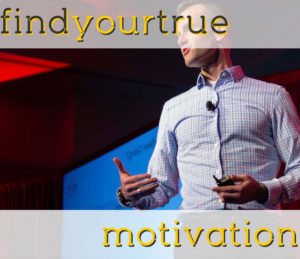
Learn how to find the right career path by figuring out why you’re walking that path in the first place.
When I work with people on their careers, they usually start off feeling lost. They want to do something else in their career, but don’t know what it is or how they are going to land that great job they long for.
They’re always surprised when I tell them we are not going to figure that out right now. I tell them, “Before we work on what you do, we need to figure out why you do it. How can you possibly find the right path except by chance unless you know why you are walking on that path in the first place?”
There’s a famous TED talk by Simon Sinek about how people do not buy what you sell, they buy why you sell it. Well, you’re no different: You don’t “buy” what you do, you “buy” why you do it. You cannot expect to have a rewarding career you love unless it ties to your underlying motivation.
So many of us went into careers without really stopping to think, “Why?” Or, equally likely, the person we were when we started working is markedly different than who we are today. Our values evolve. Our life experiences and situations change. We have different responsibilities.
Subsequently, our motivations may evolve. It may also mean we have not yet found that real, enduring, profound motivation that is our “why.”
Creating the right kind of motivation to ensure you are successful means really knowing yourself: your fears, your aspirations, your insecurities, your hopes, your dreams, your interests, your disinterests. That can be scary and it can seem daunting.
To help get there, I ask four key questions to help people discover true motivation:
What are your most important values that define your sense of right and wrong, good and bad?
What is so important to your very being that you can’t imagine losing it or not having it in the first place?
If someone were to look back on your life, how would you want him or her to think you lived it? What do you want him or her to think you lived it for?
No matter what happens, what will you always care about?
With every answer, challenge yourself. Ask yourself why that is the answer. For example, if you say honesty is your most important, defining value, ask yourself why that is. Try to get under the surface of why you believe what you believe.
Answering these questions may not immediately spell out your own true motivation, but they’ll help you understand yourself and what makes you tick so that you can pull your motivation from that deeper understanding. That’s the tough part of the process, but the part that is most crucial to create a true, lasting drive to do better and be better.
We take that drive, apply it to a goal, like finding the perfect job, and get at it with each day we do.
This post is inspired by my best-selling book, “Do a Day: How to Live a Better Life Every Day” available in print, ebook and audiobook formats. It originally appeared in my Inc.com column on July 19th, 2017.
Ask Yourself These 4 Questions to Find What Really Matters to You in Your Career

Learn how to find the right career path by figuring out why you’re walking that path in the first place.
When I work with people on their careers, they usually start off feeling lost. They want to do something else in their career, but don’t know what it is or how they are going to land that great job they long for.
They’re always surprised when I tell them we are not going to figure that out right now. I tell them, “Before we work on what you do, we need to figure out why you do it. How can you possibly find the right path except by chance unless you know why you are walking on that path in the first place?”
There’s a famous TED talk by Simon Sinek about how people do not buy what you sell, they buy why you sell it. Well, you’re no different: You don’t “buy” what you do, you “buy” why you do it. You cannot expect to have a rewarding career you love unless it ties to your underlying motivation.
So many of us went into careers without really stopping to think, “Why?” Or, equally likely, the person we were when we started working is markedly different than who we are today. Our values evolve. Our life experiences and situations change. We have different responsibilities.
Subsequently, our motivations may evolve. It may also mean we have not yet found that real, enduring, profound motivation that is our “why.”
Creating the right kind of motivation to ensure you are successful means really knowing yourself: your fears, your aspirations, your insecurities, your hopes, your dreams, your interests, your disinterests. That can be scary and it can seem daunting.
To help get there, I ask four key questions to help people discover true motivation:
What are your most important values that define your sense of right and wrong, good and bad?
What is so important to your very being that you can’t imagine losing it or not having it in the first place?
If someone were to look back on your life, how would you want him or her to think you lived it? What do you want him or her to think you lived it for?
No matter what happens, what will you always care about?
With every answer, challenge yourself. Ask yourself why that is the answer. For example, if you say honesty is your most important, defining value, ask yourself why that is. Try to get under the surface of why you believe what you believe.
Answering these questions may not immediately spell out your own true motivation, but they’ll help you understand yourself and what makes you tick so that you can pull your motivation from that deeper understanding. That’s the tough part of the process, but the part that is most crucial to create a true, lasting drive to do better and be better.
We take that drive, apply it to a goal, like finding the perfect job, and get at it with each day we do.
This post is inspired by my best-selling book, “Do a Day: How to Live a Better Life Every Day” available in print, ebook and audiobook formats. It originally appeared in my Inc.com column on July 19th, 2017.
August 2, 2017
4 Things Smart Interns Do to Get Themselves a Job Offer

How to make sure your internship ends on a high note to score that dream job after graduation.
You landed that coveted internship, and killed it all summer. Amazing. That was all you had to do to convince your manager to offer you that full-time dream job for after graduation, right?
Wrong. As your internship comes to a close, there are four crucial things you must do to increase your chances of being offered a full-time role, or at least cement a solid recommendation for whatever you go on to do next.
And managers, you think your amazing intern did a solid job on everything you threw at them, so you’re sure you should make them an offer. That’s not enough! These four actions will tell you if you’ve got a real all-star worthy of that coveted offer in your midst or not.
1. Show what you know
I have had several interns under me over the years, and two recent ones really nailed this tip. They put together a report sharing the insights from their work. It was structured as findings from their work that we could implement to improve our business.
Secretly, they were demonstrating that they really dug into their assignments, learned a ton, understand our business, and can provide valuable insights into our future. They also showed they have excellent business writing and presentation skills, to boot.
No one asked either of them to write their findings into a proposal or report, but they took the initiative and it paid off.
2. Get a review
Feedback is important for your growth, and how you seek out and receive it is so important for showing the kind of employee you will be.
Are you someone set in your ways who does not want to grow and cannot take constructive criticism, or are you someone looking for opportunities to do better that is hungry for real feedback you can put into action?
Ask your direct manager if you can set time to get feedback on how the internship went, how your work was, and what you can work on to keep growing. During the interview, be as open as you can be to the feedback, and if they do not share things you could improve, ask for them directly.
A great question to prompt this (and the idea of you coming back full-time) is, “If I wanted to work here after graduation, what would you recommend I focus on to be as successful as I can be?”
Be sure to ask about next steps after the internship if you are interested in working with the company in the future (even if it is for a different unit or department).
3. Leave no loose end behind
This is an obvious point to make, but you would be surprised how often people end internships with work mid-flight. This is as much on your manager as you, but you can certainly control it from you end.
Make sure you finish everything you started that can be finished, or make sure it’s handed off completely. If it is finished, make sure your manager knows this (an easy way to do so is by doing the first tip, and talking about it in the second tip).
4. Leave on a high note
As you start the last morning of your internship, before you lose access to company email, send out a farewell email to everyone you worked with to say goodbye, tell them what an amazing experience you had, and thank them for all they contributed to your time there. You can also ask to stay in touch, and share a link to your LinkedIn profile.
For people you worked with closest, go beyond the email, and do an in-person goodbye, thanking them for all they did to help you over the course of your internship. This is a great chance to ask if you could count on someone for a reference down the road.
Internships can be so valuable to your career, but only when you make them as valuable as they can be. Make them miss you when you go by ensuring you leave on a high note.
For employers, a great intern may not make a great employee if they can’t transition into being more independent initiative-takers. Watch for how they exit to see if they have what it takes to help drive your business forward.
This post is inspired by my best-selling book, “Do a Day: How to Live a Better Life Every Day” available in print, ebook and audiobook formats. It originally appeared in my Inc.com column on July 18th, 2017
July 26, 2017
Paralyzed by Fear of Failure? Here’s How to Break Free & Succeed
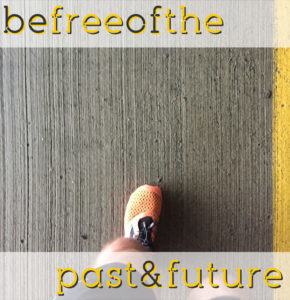
Ever made a mistake in business or been afraid of failing in your career? Free yourself from the past and future to unlock success in the present.
Have you ever made a mistake in business? Have you ever been afraid of failing in your career?Whether living with the self-judgment of past mistakes or anticipation of something that might befall you tomorrow, performing today with these pressures sets you up to fail now. Instead, focusing your mind on what you have to do today will set you up for long-term success.
I made a major mistake on a big project as a consultant. It was very public, and had a multi-million dollar implication. As soon as I realized it, I owned up to it, apologized, and worked hard to make things right. Unfortunately, I let that mistake weigh heavily on me every day, living in fear of being fired and feeling a need to defend myself at every turn. While the actual mistake was contained within a week, my actions remained defined by the mistake for the following month, all the way up to my annual performance review. I went into the meeting convinced I’d be knocked for the mistake.
Guess what happened? Not a word was mentioned about that mistake. Instead, the focus was on my attitude over the past month, and how difficult I had become to work with. I was defensive and suspicious. So the actual mistake was irrelevant. I had taken responsibility, fixed it, and the world moved on within days. Instead, my remaining stuck in the past is what brought me down.
When it comes to anticipation of things yet to come, you can see how the impact of overly focusing on tomorrow can be detrimental even if what you are focused on is positive. How many times have you had some big, exciting thing happening the next day and found yourself unable to sleep because you were so excited. You end up totally exhausted because your mind was consumed on something in the future. Or you can completely miss out on current experiences because you’re consumed with future ones. I remember the days when I first met my wife during business school, and how I was always thinking about what I’d say when I saw her next. I literally have no memory of a couple of weeks of my life from that time, but know that I performed pretty poorly in class during that time because I could not bring my mind to bear on the present moment.
Michael J. Fox famously summed it up on The Ellen DeGeneres Show in 2012 when he said:
“Don’t imagine the worst…If you imagine the worst and it happens, you’ve lived it twice.”
Let me ask you, how can you handle the present if you’re overwhelmed by what was or overly focused on what will be? The answer is simply that you cannot, or that you cannot be focused in the way you would be if you were unencumbered by the past and future. And the cost of not being present impedes your ability to succeed. This focus on what you are living right here, right now, is called, “mindfulness.”
A famous quote from Buddha summarizes mindfulness perfectly. He said:
-->
“Do not dwell in the past, do not dream of the future, concentrate the mind on the present moment.”
Mindfulness is about being in the here and now. Not the before. Not the later.
We do this by actively choosing to focus on right now. We have to be present in that decision to keep thoughts of yesterday or tomorrow from taking over. Thoughts of the past and future can drive insecurities in us around our failures or how we might fail in the future. These thoughts can spark anxiety over how we were perceived, how we will be perceived or whether we can really achieve what we’re trying to achieve. We then make choices and take actions from this place of insecurity or anxiety. I say to my coaching clients and at work all the time, “When we make decisions from a place of insecurity, we make bad choices.”
This post is inspired by my best-selling book, “Do a Day: How to Live a Better Life Every Day” available in print, ebook and audiobook formats. It originally appeared in my Inc.com column on July 12th, 2017
July 21, 2017
The 4 Ingredients of Motivation You Need to Succeed
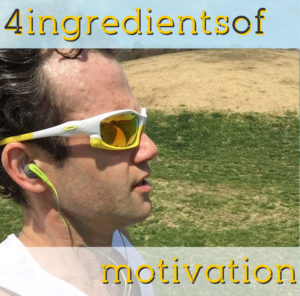
People go after big goals only to lose their drive or fail. Why? They lack real motivation. Learn the ingredients to find yours.
A lot of people go after goals in business or in life only to find themselves not making progress and losing their drive. Think of all the broken New Years Resolutions people make each year. Why is that? Your goal may be fine, but you may not have a good enough reason to go for it. That is, you may lack real motivation.
Real motivation has four key components to it:
Deep within you
Your true motivation must live in a very deep part of you. It’s something that is always with you, and so personal and strong, it could bring you to tears. For most parents, the answer is often tied to your kids. For some people I’ve worked with, it’s something tied to their mortality. For others, it’s about wanting a better life than what they grew up with. Wanting to feel pride in themselves every day, rather than shame or sadness, drives other people I’ve coached.
Enduring
True motivation must endure. It shouldn’t be something tied to a specific event that will pass. How can you stay motivated by something that stops? When I share my motivation, which is to be there and be a great example for my son throughout his life, it helps drive the point home. This isn’t about a specific event I want to be fit for, like a high school reunion, or something I want to be able to afford to buy like a new car. My son isn’t going anywhere, and my responsibilities to him as his father don’t end.
Profound
If it isn’t obvious yet, your motivators need to be big, powerful things in your life. They shouldn’t be frivolous or petty. Surviving, inspiring your kids, being there to provide for your family, having an impact on the market or society, being there to enjoy life with your family — these are big, powerful, profound things.
Non-material
Some people are motivated by money and having things. I’ve certainly worked hard and been driven to succeed professionally, and by extension financially. But the problem with material motivators is that they’re outside of you and can come and go. They might be big or expensive, but that doesn’t make them profound. They lack that deep connection to your inner self, and instead focus you on the outside world to things that are fleeting.
That’s not to say that aspiring to be the CEO of a company is necessarily material. That depends on the why — your reason. Do you want the role because CEOs tend to be well paid, or do you want it because you want to be a leader with great responsibility and the ability to grab opportunity and transform an organization? If it’s the latter, you will choose to invest in yourself for your personal and professional growth. You will work on inspiring others as a leader. You will work on developing your business savvy and acumen to find and seize opportunities, creating rewards and jobs for others.
Think about what drives you, and whether it fits these four pillars of successful motivation. If not, probe deeper within yourself, ask the tough questions and challenge your answers. Once you unlock your true motivation, you unlock the key to achievement.
This post is inspired by my best-selling book, “Do a Day: How to Live a Better Life Every Day” available in print, ebook and audiobook formats . It originally appeared in my Inc.com column on July 5th, 2017
June 3, 2017
Review: Mizuno Wave Sky

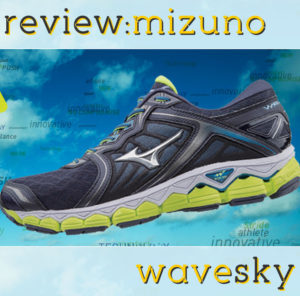 Mizuno sent me a pair of their brand new Wave Sky running shoes to test out. Full disclosure, this is a sponsored review, but my views are 100% my own, and I was free to speak my mind. I went into this expecting not to have a ton of good stuff to say…read on to find out if I was right or wrong.
Mizuno sent me a pair of their brand new Wave Sky running shoes to test out. Full disclosure, this is a sponsored review, but my views are 100% my own, and I was free to speak my mind. I went into this expecting not to have a ton of good stuff to say…read on to find out if I was right or wrong.
the buildup
I used to run exclusively in Mizunos, especially the Wave Evo line. When that was discontinued, I’ve struggled to find Mizunos that had the same smoothness of the ride as the Evos. Everything I tried was just a bit too hard. I’ve run in several generations of the Rider (good shoe, for sure – see my reviews of versions 18 and 20 of the Wave Riders), Sayonara, Hitogami (both version 1) and a few others (like the Universe 5, which is my preferred 5K racing flat). They just didn’t hit the right mix for me.
I got the Wave Sky from Mizuno to evaluate for my blog, and I was skeptical as soon as I took them out of the box. I wore them around the house, and thought they’d be as firm as the Riders, which isn’t my style. I finally got them out on a run yesterday as I’ve been recovering from a sprained ankle.
my impressions
Let me just say, I stand SERIOUSLY corrected. I was blown away by the ride. The shoe is firm when you walk around (thanks to the Wave plate, I’m sure), but once you load them up with force while running, they just melt. Not since the Wave Evo Cursoris have I felt a Mizuno disappear like this. I’m a forefoot striker, and found them really easy to strike that way, which is usually tough in a firm shoe. I then tried mid foot striking, and they were a dream.
I have to say, I expected to think they were fine but not for me. Now that I’ve run in them, I can say that they’re way better than fine – they’re actually an excellent shoe for mid distances (and I’d say they can probably handle a marathon really well, too), and would work well for pretty much any strike you run with. I wouldn’t wear them in a 5K as I like a racing flat for that use, but anything over 5K and any training run, I’d definitely choose them.
I would also note that the sole is completely covered in rubber. That’s not too common these days as most manufacturers have been cutting back on rubber to reduce weight. Mizuno clearly was thinking that the Sky would be a durable road shoe. They do weight a bit much vs others out there, but they’re not terribly heavy. That’s the price you pay for durability, and I at least recognize and appreciate them offering something that should last. Again, this speaks to the appropriateness of the shoe for middle distances up through the marathon.
Great toe box, heel cup, tongue, good lacing and hold…just really happy with this shoe, and a total surprised. Such a good reminder that you can’t judge a running shoe by walking around in it.
my depressions
Honestly, I’m struggling here. I think the look of the shoe is a bit subdued. It’s not bad, but it’s just kinda conservative. I’ve been running in louder shoes lately, so this was a step backward for me, but I’d at least say most people will be fine with them. You just won’t be like, “Oh wow, that’s a hot shoe! I gotta get those!”
I noted their weight above, and would call that out in the ‘depressions’ section since it is a drawback. I just think this is an intentional tradeoff Mizuno made, and it’s no secret. If you need a durable shoe, then you likely will have more weight.
One thing I do think is valid as a complaint is on the pricing. $149 retail is on the higher end of the market, and just feels too high for a shoe that seems so conservative. I will say that the huge amount of rubber on the sole suggests these things will last a long time, so I expect you’d at least get your money’s worth (vs many similarly-priced shoes with more exposed foam on the sole).
to buy or not to buy
I think you can tell that I’m a fan of these, and I really didn’t expect to be, so that says even more about how much I ended up liking them since I was biased against them. I do wish they had some flashier colorways (though that’s not really Mizuno’s style these days), but otherwise, they are what they’re intended to be, and do a good job of being just that. I may have just accidentally stumbled on a new favorite shoe. They’ll at least be regulars in my rotation, and I’m glad to have them in there.
If you’re interested in learning more or picking up a pair of Wave Sky shoes, you can get them direct from Mizuno at this link. Finding a shoe that works for how your body moves is crucial to enlighten.your.body.
October 23, 2016
Review: Mizuno Wave Rider 20
the buildup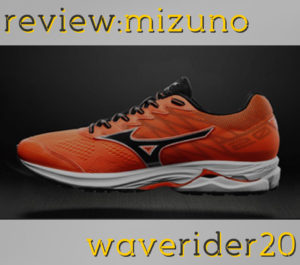 I’ve been running in Mizuno shoes for years. Their Wave Evo line became my favorite shoes, and remains that to this day. The only problem with them is that Mizuno dropped the line, so once my last pair wears out, that’ll be it. I’ve tried a few other Mizunos, and generally liked them, but they have never really fit my running style, which is forefoot striking aka toe running, which requires a really flexible, softer shoe than most traditional shoes. And outside of the Wave Evo line, most Mizunos are pretty traditional.
I’ve been running in Mizuno shoes for years. Their Wave Evo line became my favorite shoes, and remains that to this day. The only problem with them is that Mizuno dropped the line, so once my last pair wears out, that’ll be it. I’ve tried a few other Mizunos, and generally liked them, but they have never really fit my running style, which is forefoot striking aka toe running, which requires a really flexible, softer shoe than most traditional shoes. And outside of the Wave Evo line, most Mizunos are pretty traditional.
A couple of years ago, I got a pair of Wave Rider 18s to test. You can see the video of my review  here, but in short, I found them too structured (that is, not flexible enough), with far too firm of a sole for the kind of flex I need for running on my toes. They’d be a better choice for a mid-foot or heel striker, and are better for distance than short runs.
here, but in short, I found them too structured (that is, not flexible enough), with far too firm of a sole for the kind of flex I need for running on my toes. They’d be a better choice for a mid-foot or heel striker, and are better for distance than short runs.
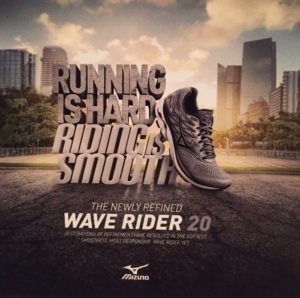 I was given the opportunity to review the new Wave Rider 20, and after seeing pre-release photos of it, I was very curious. Right off the bat, you can see that it’s a less structured shoe than the 18, with more flexible, pliant materials throughout the upper. When I went to bend them, they were similarly stiff to the 18s, so I was pretty skeptical of how they’d run. According to Mizuno, the Wave Rider 20 maintains Mizuno’s classic fit while also featuring a breakthrough in cloud wave technology that provides an overall softer, smoother ride.
I was given the opportunity to review the new Wave Rider 20, and after seeing pre-release photos of it, I was very curious. Right off the bat, you can see that it’s a less structured shoe than the 18, with more flexible, pliant materials throughout the upper. When I went to bend them, they were similarly stiff to the 18s, so I was pretty skeptical of how they’d run. According to Mizuno, the Wave Rider 20 maintains Mizuno’s classic fit while also featuring a breakthrough in cloud wave technology that provides an overall softer, smoother ride.
So with that background, I’d just add that Mizuno provided me these shoes to write a sponsored review. While this may be a sponsored post, I’m sharing my own views freely.
my impressions
As I mentioned above, the shoe is clearly more comfortable and compliant than the 18 (I never tried the 19, but these look different than the 19, too). Most of the shoe is a mesh material, while there’s vinyl providing more structure along some of the side and around the laces, with a closed throat at the bottom of the laces (meaning the shoe can only get so wide no matter how much you loosen the laces). That concerned me when I saw it, but as soon as I slipped the shoe on, I really had no problem with width. And with my toe striking, my feet are definitely wider up front than people who live their lives in narrow-toed shoes and run on their heels. The interior is also really comfortable, being nicely padded without being overdone. I found no seams or hot spots inside, which is nice (and something I am fearful of with closed throat shoes).
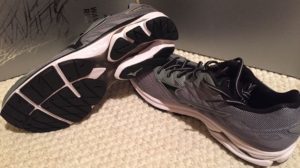 I have to make one comment on something that may seem silly. The laces are awesome. I get so annoyed when a single bow results in laces coming undone every mile or so, which seems to be how things just are with laces these days. I don’t know why, but most shoes come with fairly stiff laces that just don’t like to stay tied. The Wave Rider 20s have these really soft, supple, compliant laces. I can’t see them coming undone at all. I know, I know, who cares, right? Well, I care. Having had to stop twice when running the Chicago Marathon to retie laces I had even double knotted, maybe I’m more sensitive to this, but little things matter.
I have to make one comment on something that may seem silly. The laces are awesome. I get so annoyed when a single bow results in laces coming undone every mile or so, which seems to be how things just are with laces these days. I don’t know why, but most shoes come with fairly stiff laces that just don’t like to stay tied. The Wave Rider 20s have these really soft, supple, compliant laces. I can’t see them coming undone at all. I know, I know, who cares, right? Well, I care. Having had to stop twice when running the Chicago Marathon to retie laces I had even double knotted, maybe I’m more sensitive to this, but little things matter.
OK, so on to what matters. Let me focus on what I felt when mid-foot and heel striking, which I tested. The shoe is really nice. It’s stiff, but the whole idea behind the Wave technology – including the new Cloud Wave version Mizuno has introduced with the Wave Rider 20 for an overall softer smoother ride. The Wave is meant to transfer energy from the strike through the rest of the shoe, providing for better snap in lift off. It’s like how tendons work – load energy into the wave plate (which is plastic), and it will snap, helping to propel you forward. You don’t notice anything awkward or uncomfortable, but you do notice that the shoes have a really good ‘pop’ to them. Mizuno talks a lot about “Riding” in their marketing materials (obviously, given the name), but the idea behind it is genuine – the shoe should be facilitating ‘riding’ through your run rather than pounding through it. You strike, and the energy rides the wave plate to help you move forward. Flow rather than effort.
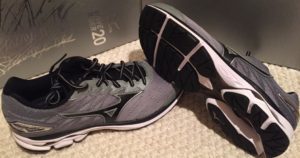 And the cushioning, featuring Mizuno’s U4ic foam (“euphoric,” get it?), is really nice. It’s dense, but has a nice cushioning or absorption to it. Because it’s dense, you don’t feel a squish or like the your energy is being lost, but the cushioning feel keeps it from feeling hard. That’s impressive since there’s a huge amount of carbon rubber across the bottom of this shoe – literally covering every strike surface (as you can see in the photos). That’s great for durability, but does generally increase weight and make for a harsher ride. Mizuno has done a really nice job of balancing all of that out in the Wave Ride 20s, and they just feel good from a cushion standpoint. In terms of distance, I’d say they’re fine for a 5K, but are really better for something like a half marathon or longer. 10K could work, too. I just like a more compliant shoe, and would err on the side of less weight and cushion for a shorter race since you don’t really need it in the shorter distance, and will benefit from reduced weight.
And the cushioning, featuring Mizuno’s U4ic foam (“euphoric,” get it?), is really nice. It’s dense, but has a nice cushioning or absorption to it. Because it’s dense, you don’t feel a squish or like the your energy is being lost, but the cushioning feel keeps it from feeling hard. That’s impressive since there’s a huge amount of carbon rubber across the bottom of this shoe – literally covering every strike surface (as you can see in the photos). That’s great for durability, but does generally increase weight and make for a harsher ride. Mizuno has done a really nice job of balancing all of that out in the Wave Ride 20s, and they just feel good from a cushion standpoint. In terms of distance, I’d say they’re fine for a 5K, but are really better for something like a half marathon or longer. 10K could work, too. I just like a more compliant shoe, and would err on the side of less weight and cushion for a shorter race since you don’t really need it in the shorter distance, and will benefit from reduced weight.
As for weight, the Wave Rider 20s aren’t heavy, but they’re also not lightweights. I’d say – like most competitive shoes these days – they’re lighter than you’d expect, but I think equivalent Sauconys would be lighter. Still, they’re not heavy, and I didn’t notice their weight when running.
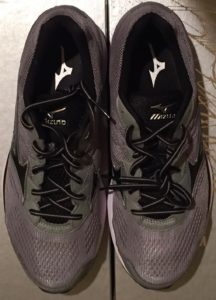 As for fit, I wear 10s, but generally wear 9.5s in Mizuno (men’s US size) across Evo Levitas, Evo Cursoris, Evo Ferus, Sayonara, Hitogama, Universe and Rider (I told you I’ve run in a lot of Mizunos). These 9.5 fits me really well. I wore the same size in the 18s, and had a similarly good fit, so I’d say Mizuno has stayed consistent in their sizing.
As for fit, I wear 10s, but generally wear 9.5s in Mizuno (men’s US size) across Evo Levitas, Evo Cursoris, Evo Ferus, Sayonara, Hitogama, Universe and Rider (I told you I’ve run in a lot of Mizunos). These 9.5 fits me really well. I wore the same size in the 18s, and had a similarly good fit, so I’d say Mizuno has stayed consistent in their sizing.
Lastly, the style is pretty nice. They’re not crazy, but look good. I got these light gray color, while there’s also an awesome orange color (I was hoping for that when I opened the box). There’s also a blue that looks kinda purply online, but maybe not in person. The gray ones don’t look great online, but do in person, so the blue could be good. The orange is really nice, though…if you like to be loud with your shoes (which I do).
Retail pricing is $119, which is pretty common for this type of shoe. It’s not a bargain-priced shoe, but it’s certainly not a rip off and actually much cheaper than several competing shoes.
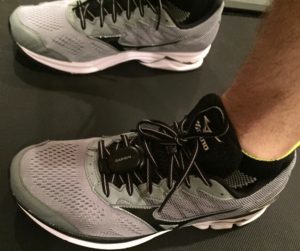 my depressions
my depressions
So you may have noticed I haven’t commented on what the shoe is like for a forefoot striker or toe runner. That’s because the section above is on the positives. So you can guess where this is going (and how you know this is an unbiased review despite it being sponsored). The Wave Rider 20 is really not for a toe runner. That doesn’t mean I couldn’t run in them, because I did. It just means it wasn’t ideal. The best runs are the ones where the shoes disappear – I always feel that with the Wave Evo Cursoris and Levitas (especially the second gen versions). I rarely have felt it with other shoes, and I was conscious of every single foot strike in the Rider 20s. This is for two reasons – one is that the sole is firm, which means I’m expending a lot of energy getting it to bend to my will to run on my forefoot. The second is that the wave plate ends around the ball of the foot, and create a sense of there being a raised surface there. I felt like I was running with half a ball mounted on the bottom of my shoe (not quite that bad, but that sort of idea). Again, it was doable, but you can imagine that doesn’t make for a really zen-like running experience.
I did alter my strike a little into more of a mid-foot strike, and that helped, but that’s not how I run, and I don’t believe in changing how I run to accommodate a shoe. I believe in finding a shoe that’s made for my running style. I also tested heel striking at this point, and, again, it was doable, and I could see how this shoe would be a good fit for someone who strikes that way, but again, it’s just not me.
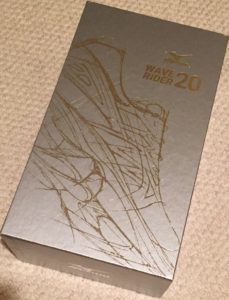 Special Pre-Release Packaging. Very slick (and shiny)
Special Pre-Release Packaging. Very slick (and shiny)to buy or not to buy
Well, the first thing you need to do to answer the age old question of whether you should buy these is how you run. If you toe strike, I’d suggest looking for something else (look, that’s the toe striker’s curse – most shoes aren’t really made for toe striking, it seems – either they’re too built for heel striking with a big drop and stiff sole, or they’re too narrow for our toe box needs that have been beaten into being wider than many shoes). I could actually see myself considering running in these more, which I couldn’t say of the 18s, but I should probably just move on to something more fit to my style.
If you are a heel striker or mid-foot striker, then I’d say these should seriously be contenders. They have a great blend of design decisions from the mesh upper, good level of upper structure without being over-done, great foam cushion trade offs for higher mileage runs, and a really excellent power transfer technology with the Cloud Wave.
Mizuno says, “After nearly two decades of refinement, our latest Wave Rider is guaranteed to exceed all expectations.” Honestly, if you fit the second group listed above, I’d say that this is a pretty accurate statement. I actually didn’t have high expectations because overall I wasn’t a fan of the 18th, so they actually did exceed my expectations.
If you’re interested in learning more or picking up a pair, you can get them direct from Mizuno at this link. Finding a shoe that fits your needs and movement style is so crucial. In fact, doing so is a key input when you are trying to enlighten.your.body.
July 30, 2016
The Value of Being Extremely Consistent
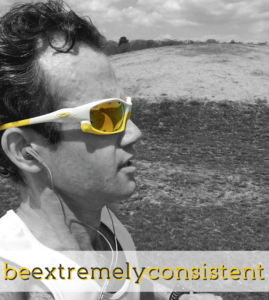 Last year, I trained for and completed the 2015 Chicago Marathon on behalf of St. Jude. It was an amazing experience, and the training did more than just get me ready for the race, but also conditioned my body in a way I never imagined possible while also allowing me to rack up mileage I didn’t think I’d ever run in a year. My training plan alone called for 705 miles, and there were still seven months of the year left for more running. I finished the year at about 950 miles (I started the year with an injury, so I really only ran for about eight months). Doing the marathon also meant I was generally at the top of the various social fitness platforms I’m a part of (Nike+, Garmin Connect, DailyMile, Strava, MapMyRun, MyFitnessPal). This year, I have no races planned, and certainly nothing like a marathon is in the cards as my job has made fitting in that level of training extremely tough. So I had no expectations of being at the top of any leaderboards and certainly not surpassing the miles I ran last year.
Last year, I trained for and completed the 2015 Chicago Marathon on behalf of St. Jude. It was an amazing experience, and the training did more than just get me ready for the race, but also conditioned my body in a way I never imagined possible while also allowing me to rack up mileage I didn’t think I’d ever run in a year. My training plan alone called for 705 miles, and there were still seven months of the year left for more running. I finished the year at about 950 miles (I started the year with an injury, so I really only ran for about eight months). Doing the marathon also meant I was generally at the top of the various social fitness platforms I’m a part of (Nike+, Garmin Connect, DailyMile, Strava, MapMyRun, MyFitnessPal). This year, I have no races planned, and certainly nothing like a marathon is in the cards as my job has made fitting in that level of training extremely tough. So I had no expectations of being at the top of any leaderboards and certainly not surpassing the miles I ran last year.
This year, without really planning to, I started a running streak of doing at least 5K every day (if you follow me on social media, you’d see a lot of posts with “#5KEveryDay”). I had to take a break due to a broken bone in my foot that was acting up, but I’m back at it, and doing well.
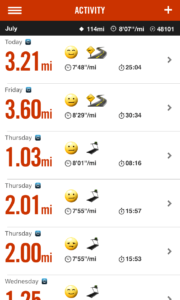 July 2016 Nike+ Activity
July 2016 Nike+ ActivitySo the other morning after a run, I wondered how my mileage was stacking up against last year. Turns out, I’m actually on track to surpass last year’s mileage, and even break through the 1,000 mile mark! As of writing this, I’ve run 587.1 miles, and am consistently breaking 100 miles per month (I’m at 114 for July, with one day left to go). At this pace, I could even break 1,100 miles this year.
I’ve also been at the front of the leaderboards pretty much every month I’ve been able to run. And two of my friends are training for marathons. I don’t expect to stay at the front as they get into much longer long runs, but it’s been really surprising to me.
Fitness-wise, I am also in similar shape to how I was during the training. My weight is within a couple of pounds, my body fat is essentially the same, and I’ve been sick and injured the same or less.
[tweet_box design=”default”]Something is better than nothing, so #dosomething and #value what you do.[/tweet_box]
So why am I writing this? Not to brag or pat myself on the back. I’m writing this to share the idea that you don’t have to do something profound to do well. You don’t have to climb mount Everest to be a good climber. You don’t have to write a best selling book to be a good writer. You don’t have to be a classically trained chef to cook good food. For me, I’ve seen first hand how putting in the work consistently is just as valuable as putting in extreme work. Just because you can’t do something huge, doesn’t mean you shouldn’t do anything. Something is better than nothing, so do something and value what you do. Allow it to be great. [tweet_dis]Let the #success of what you are doing to matter[/tweet_dis].
Achieving is important. Recognizing your achievements is just as important. Achieving is for the physical, recognizing is for the mental, and both are how you enlighten.your.body.
July 16, 2016
Review: Healthy Skoop B-Strong Protein
 I’m a vegan. I didn’t mean to be, but it just kinda happened. And I’m really happy with it, and find it easy to maintain, much to the shock and surprise of others. I’m also an athlete who has been very focused on getting a lot of protein in my diet. The top question I get is the age old, “So how do you get protein if you don’t eat meat?”
I’m a vegan. I didn’t mean to be, but it just kinda happened. And I’m really happy with it, and find it easy to maintain, much to the shock and surprise of others. I’m also an athlete who has been very focused on getting a lot of protein in my diet. The top question I get is the age old, “So how do you get protein if you don’t eat meat?”
I get it lots of ways without really having to try. I love quinoa, lentils, black beans, hemp seeds, chia seeds, nuts, nut butters, and many other foods that are good sources of protein. But sometimes when I’m training hard, I like to ensure I’m getting more protein, so I use protein shakes. Some naysayers out there might call me out for cheating to get protein where a ‘normal’ person eating meat and eggs wouldn’t need a supplemental shake. I beg to differ – when I was a meat eater who had two to three eggs for breakfast (plus lentils), I still used a protein shake every day. If anything, I actually supplement less now than I used to.
What has changed is the way I supplement. Or I could be clever and say, “the whey I supplement.” I used to use dairy-based protein shakes using whey or casein. Those are the two main proteins in dairy, with whey being a fast-digesting protein that’s ideal for times when your muscles are working hard or just worked hard (recovery). Casein is a slow-digesting protein that’s ideal for times when you don’t have a strong physical demand, like with dinner, before bed. I used to eat a cup of cottage cheese before bed (cottage cheese is basically just casein plus milk fat and some lactose, or dairy sugar).
But being vegan means no dairy, so I turned to a few brands of plant-based protein powders. These powders rely on soy, pea, hemp and brown rice proteins, but I’ve always tried to avoid soy protein because it has a hormonal impact (it increases estrogen levels) that men or women with a high risk of breast cancer should be mindful of. The two brands I mainly used are Vega (Vega One and Protein+Greens were the two I used, though I didn’t like either due to their overly-fake taste and relatively low protein for a high volume of powder) and Garden of Life RAW Protein. I much prefer the GoL stuff because, unlike the Vega, it’s organic. That’s really important to me to avoid the chemicals used in non-organic agriculture. The protein load is also better than the Vega, and the pricing is better, too (you can get it on subscribe and save through Amazon for a good price). The taste isn’t bad, but it’s not great, either. And I have a different issue with the GoL products that means I need to stay near a bathroom right after drinking it, and I can’t drink it and start working out. Let’s leave that point there.
 So my main options I’ve relied on weren’t great options. As a FitFluential ambassador, I became aware of Healthy Skoop (see their full line at Amazon). It immediately caught my attention. Their B-Strong Protein is plant-based, aka vegan. It’s organic. It’s low sugar (3g per scoop, which is less than Vega but slightly more than GoL). And it doesn’t have soy in it. Check check check. The protein content is pretty good at 16g per scoop, but not the best. It’s certainly sufficient, though. Healthy Skoop was offering to provide a container of their powder for some social media love, which I agreed to do. So, yes, full disclosure – I didn’t pay for this product. What wasn’t asked of me, though, is to write a blog post – I’m doing that totally of my own volition because of how strongly I feel about the product.
So my main options I’ve relied on weren’t great options. As a FitFluential ambassador, I became aware of Healthy Skoop (see their full line at Amazon). It immediately caught my attention. Their B-Strong Protein is plant-based, aka vegan. It’s organic. It’s low sugar (3g per scoop, which is less than Vega but slightly more than GoL). And it doesn’t have soy in it. Check check check. The protein content is pretty good at 16g per scoop, but not the best. It’s certainly sufficient, though. Healthy Skoop was offering to provide a container of their powder for some social media love, which I agreed to do. So, yes, full disclosure – I didn’t pay for this product. What wasn’t asked of me, though, is to write a blog post – I’m doing that totally of my own volition because of how strongly I feel about the product.
I got the Choco-lot flavor, which is flavored using organic cocoa plus some coconut sugar and stevia, both also organic. Every item in the short ingredient list is organic. It’s not too sweet at all, and not chalky or bitter as some chocolate protein powders can be. It’s really the perfect balance of sweet without being too strong or fake.
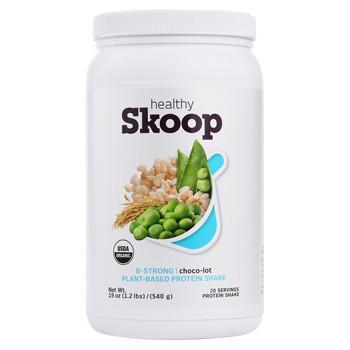 I put a scoop in my blender bottle as soon as I got the package in the mail because I was so anxious to try it. One issue I’ve had with different protein powders is that some don’t blend well. They clump or stick to the walls of the bottle or blender. This stuff mixed really well, really quickly. It’s a minor point, but it matters – that’s wasted product and a more involved cleanup process if it sticks or clumps.
I put a scoop in my blender bottle as soon as I got the package in the mail because I was so anxious to try it. One issue I’ve had with different protein powders is that some don’t blend well. They clump or stick to the walls of the bottle or blender. This stuff mixed really well, really quickly. It’s a minor point, but it matters – that’s wasted product and a more involved cleanup process if it sticks or clumps.
I took a swig. Wow. It tastes like melting chocolate ice cream (though not quite as sweet). It has a light creaminess to it that was just so nice. It went down smoothly without coating my mouth (or the cup, which didn’t have the typical protein shake residue left on it).
Next step was to wait to see if I needed to rush to the bathroom like I would with Garden of Life. Five minutes…10 minutes…20 minutes. All clear. So that was the last test, and it passed.
Then the test was how it did at fueling me. Without drawing blood or doing muscle tissue samples over time, my sense of how it worked isn’t scientific, but I can say I was not feeling great this morning and was strongly considering not exercising. I had a shake, and definitely felt a little better. Better enough to decide to run just a mile on the treadmill for the sake of getting some movement. Usually my first mile of any run is sort of a throwaway. I’m just getting in the groove, and it generally feels like it takes for ever for my Garmin to vibrate to tell me I hit my first mile. Not only did the first mile go quickly this morning, I actually didn’t feel my usual sluggishness. That’s saying a lot since I was feeling really sluggish before lacing up. I ended up doing two miles, but felt like I could have gone much longer. Unfortunately, I had a time constraint, so I couldn’t run longer.
Is that 100% because of the Healthy Skoop B-Strong Protein? Yes, of course. No, I’m kidding. I don’t know if it was. But it certainly was an a-typical morning for me, both in terms of feeling so physically low, and for rebounding from that feeling so quickly and strongly. The only fuel I had was the protein shake, so it wasn’t from anything else. I’d need way more time with the product to be certain, but every sign points to this being a great product. None of the problems or issues I’ve had with other products, all of the ingredient choices I’d make, great taste, and apparently a positive impact on my performance.
Last thing I needed to check was the price. Most protein powders are expensive. Most are crazy expensive. Organic ones are even more expensive. A grass-fed, organic whey protein I used to use costs about $100 – if you can find it on sale! After drinking my first shake, I was expecting Healthy Skoop to run somewhere around $60 per container, which is similar to Vega (GoL is usually in the low to mid $40s, with deals to get it to about $28). I was shocked to see that regular retail price is $45, with a subscribe and save auto-delivery price of $38.25 shipped! They have a non-organic version that sells for $30 or $25.50 with auto-delivery.
And that’s when I decided I need to write about this product and spread the word. No question I’ve concluded that I’m switching to Healthy Skoop for my own use. They’re a small company who makes a product that’s 100% in sync with what I want in a protein powder, and they care about what I care about. I feel really good using their product physically, but also personally as I’m supporting a company that’s supporting what I care about, too. That’s a win all around.
I should add that they’re socially and societally conscious about something that’s very important to me. Childhood obesity is out of control. It’s so bad, Adult Onset Diabetes has been renamed Type II Diabetes because kids are getting it. This is a lifestyle-induced diabetes due to poor diet. Healthy Skoop donates 3% of their sales (not profit, but top-line sales) to Project Produce to help get veggies into school lunches in the US. 30 million kids eat lunch provided by school, and if you’ve seen what they’re served, you know that something needs to be done to help these kids get better nutrition and eating habits.
So I’ll leave it there for now. I also got a container of their organic, plant-based greens (for cooking, adding to smoothies, etc), which I will try soon and will write about if I feel strongly in either direction, so stay tuned for that. In the meantime, you can get the organic Healthy Skoop protein from their website with a great free-shipping offer on any orders over $100 (you can stock up to get over the $100 mark) for just $45 per container, or you can get free shipping if you do the subscription plan where you get the product for just $38.25 per container. You can also get it from Amazon, if you prefer, for even less ($35.28, though no subscribe-and-save option on the all-organic version). If you’re not sure you want to commit, they have three sampler kits you can try out, too. I have no doubt you’ll be pleased when you do.
Using high-quality, clean nutrition is one of the most literal ways to enlighten.your.body.
Do a Day Blog
You can learn more about Do a Day and get links to all the ways you can get the book, coaching, or hire Bryan Falchuk as a speaker at http://www.doadaybook.com. ...more
- Bryan David Falchuk's profile
- 6 followers



